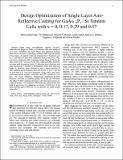Design Optimization of Single-Layer Antireflective Coating for GaAs[subscript 1−x]xP[subscript x]x/Si Tandem Cells With x=0, 0.17, 0.29, and 0.37
Author(s)
Abdul Hadi, Sabina; Saylan, Sueda; Dahlem, Marcus S.; Nayfeh, Ammar; Milakovich, Timothy J; Bulsara, Mayank T; Fitzgerald, Eugene A; ... Show more Show less
DownloadSAbdulhadi_ARC_TandemCell_October-2014_word.pdf (1001.Kb)
OPEN_ACCESS_POLICY
Open Access Policy
Creative Commons Attribution-Noncommercial-Share Alike
Alternative title
Design Optimization of Single-Layer Antireflective Coating for GaAs1−xxPxx/Si Tandem Cells With x=0, 0.17, 0.29, and 0.37
Terms of use
Metadata
Show full item recordAbstract
Single-layer antireflective coating (SLARC) materials and design for GaAs1_xPx/Si tandem cells were analyzed by TCAD simulation. We have shown that optimum SLARC thickness is a function of bandgap, thickness, and material quality of top GaAs1-xPx/Sisubcell. Cells are analyzed for P fractions x = 0, 0.17, 0.29, and 0.37, and ARC materials: Si3N4, SiO2 , ITO, 11fO2, and Al2O3. Optimum ARC thickness ranges from 65-75 nm for Si3N4 and ITO to ~100-110 nm for SiO2. Optimum ARC thickness increases with increasing GaAs1_xPx absorber layer thickness and with decreasing P fraction x. Simulations show that optimum GaAs1-xPx/Siabsorber layer thickness is not a strong function of ARC material, but it increases from 250 nm for x = 0 to1 μm for x = 0.29 and 0.37. For all P fractions, Si3N4, 11fO2, and Al2O3 performed almost equally, while SiO2 and ITO resulted in ~1% and ~2% lower efficiency, respectively. Optimum SLARC thickness increases as the material quality of the top cell increases. The effect of ARC material decreases with decreasing GaAs1_xPx material quality. The maximum efficiencies are achieved for cells with ~1-μm GaAs0.71P0.29 absorber (r = 10 ns): ~26.57% for 75-nm Si3N4 SLARC and 27.62% for 75-nm SiO2/60-nm Si3N4 double-layer ARC.
Date issued
2015-01Department
MIT Materials Research Laboratory; Massachusetts Institute of Technology. Department of Materials Science and EngineeringJournal
IEEE Journal of Photovoltaics
Publisher
Institute of Electrical and Electronics Engineers (IEEE)
Citation
Abdul Hadi, Sabina, Tim Milakovich, Mayank T. Bulsara, Sueda Saylan, Marcus S. Dahlem, Eugene A. Fitzgerald, and Ammar Nayfeh. “Design Optimization of Single-Layer Antireflective Coating for GaAs[subscript 1−x]xP[subscript x]x/Si Tandem Cells With x=0, 0.17, 0.29, and 0.37.” IEEE J. Photovoltaics 5, no. 1 (January 2015): 425–431.
Version: Author's final manuscript
ISSN
2156-3381
2156-3403